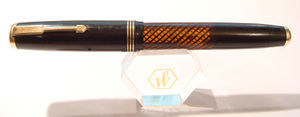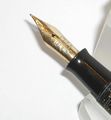Differenze tra le versioni di "Tabo Trasparente/en"
(Aggiornamento come da nuova versione della pagina di origine) |
|||
| Riga 1: | Riga 1: | ||
| − | [[Image:Tabo-Trasparente-Logo.jpg|thumb|Logo Tabo Trasparente]][[File:Tabo-Trasparente-Flatclip-3V-BlackTransp-Sr-Capped.jpg|thumb| | + | [[Image:Tabo-Trasparente-Logo.jpg|thumb|Logo Tabo Trasparente]] |
| − | == | + | [[File:Tabo-Trasparente-Flatclip-3V-BlackTransp-Sr-Capped.jpg|thumb|Una Tabo Trasparente oversize]] |
| + | ==Storia== | ||
[[Image:1943-03-Tabo-Trasparente.jpg|thumb|upright|A [[Tabo]] advertising]] | [[Image:1943-03-Tabo-Trasparente.jpg|thumb|upright|A [[Tabo]] advertising]] | ||
| Riga 24: | Riga 25: | ||
[[Image:Tabo-Trasparente-Serie-Posted.jpg|thumb|Different [[Tabo Trasparente]] versions]] | [[Image:Tabo-Trasparente-Serie-Posted.jpg|thumb|Different [[Tabo Trasparente]] versions]] | ||
| − | + | Le penne di questa serie vennero prodotte in tre diverse misure. Ci sono inoltre delle varianti che presentano diverse versioni del fermaglio, uno è quello classico a freccia della [[Tabo Mentis]], il solo mantenuto anche nel periodo successivo. A questo si aggiunge un fermaglio sagomato piatto, adottato nelle prime versioni ed uno ricurvo con terminazione triangolare recante a rilievo la sagoma di una freccia, adottato in un secondo tempo. Ci sono poi anche varianti delle verette, con banda fra due anellini, anello singolo spesso circa un millimetro e mezzo e tre anellini sottili. | |
The models with shaped arrow clip were associated both with decorations with three thin ring on the cap or with a greek motif band between two thin rings. The body and cap were slightly tapered and ending in a conical shape both for cap bottom than the end of the body. The clip was inserted in the cap by joints, as it was done in a single piece. Although they were considered the oldest, their presence in more recent advertising casts doubt on the history of these style changes. | The models with shaped arrow clip were associated both with decorations with three thin ring on the cap or with a greek motif band between two thin rings. The body and cap were slightly tapered and ending in a conical shape both for cap bottom than the end of the body. The clip was inserted in the cap by joints, as it was done in a single piece. Although they were considered the oldest, their presence in more recent advertising casts doubt on the history of these style changes. | ||
| Riga 42: | Riga 43: | ||
===Nibs=== | ===Nibs=== | ||
| − | [[File:Tabo-Trasparente-Flatclip-3V-BlackTransp-Sr-Nib.jpg|thumb| | + | [[File:Tabo-Trasparente-Flatclip-3V-BlackTransp-Sr-Nib.jpg|thumb|Particolare del pennino di una [[Tabo Trasparente]] ]] |
The pens in this series were equipped with a 14-carat gold nib, bearing the engraving ''Tabo'' in capital letters above the ''Osmiridio'' inscription all over the carat weight value inside a diamond, expressed in thousandths. The steel nib versions always have the''Tabo' above the word ''Iridium'', with no carat weight indication and only a number indicating the size of the nib. | The pens in this series were equipped with a 14-carat gold nib, bearing the engraving ''Tabo'' in capital letters above the ''Osmiridio'' inscription all over the carat weight value inside a diamond, expressed in thousandths. The steel nib versions always have the''Tabo' above the word ''Iridium'', with no carat weight indication and only a number indicating the size of the nib. | ||
Versione delle 21:19, 30 ott 2017
Storia
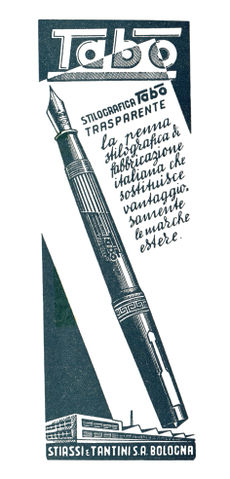
The Tabo Trasparente model, whose production began around the late 30s (we assume around 1939, but the oldest advertisement found is 1941) was probably the most successful model produced by Tabo, so that was widely advertised in many national magazines. It remained in production until the war period, albeit subject to some changes, particularly in the form of clip and on the cap decorations.
The model dismission date is unknown, we will assume 1945, but the intake is totally arbitrary, without any factual support and performed solely for the purpose of managing the chronology.
Technical features
The main technical feature of this pen is its depression filling system, a clear imitation of the Vacumatic one. The pens were also made with transparent body in order to display the ink level. The cap was screw closed.
Materials
Pens in this series were celluloid made, with gold filled metal trim and clasp, and a 14-carat gold nib, or finished in white metal and whit a steel iridium nib (for a possible autarkic version).
Filling system
These models were equipped by an original depression filling system based on the same concepts as the Vacumatic one. In this case, however, was not necessary to remove the bottom of the pen button to access the pumping button, but this was done through the end plate itself, which is coupled to a spindle screwed to the bottom of the pen. Unscrewing the bottom extended the spindle itself and then the bottom could be used to perform the pumping operation.
Versions
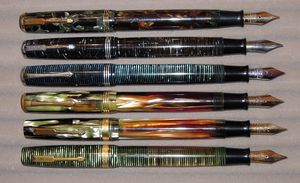
Le penne di questa serie vennero prodotte in tre diverse misure. Ci sono inoltre delle varianti che presentano diverse versioni del fermaglio, uno è quello classico a freccia della Tabo Mentis, il solo mantenuto anche nel periodo successivo. A questo si aggiunge un fermaglio sagomato piatto, adottato nelle prime versioni ed uno ricurvo con terminazione triangolare recante a rilievo la sagoma di una freccia, adottato in un secondo tempo. Ci sono poi anche varianti delle verette, con banda fra due anellini, anello singolo spesso circa un millimetro e mezzo e tre anellini sottili.
The models with shaped arrow clip were associated both with decorations with three thin ring on the cap or with a greek motif band between two thin rings. The body and cap were slightly tapered and ending in a conical shape both for cap bottom than the end of the body. The clip was inserted in the cap by joints, as it was done in a single piece. Although they were considered the oldest, their presence in more recent advertising casts doubt on the history of these style changes.
Following the Vacumatic stylistic trend were also produced some versions featuring metal decorations at the cap and barrel ends, with conical jewels entirely similar to those found on the more famous Parker model. In this case, the clip was screw mounted on cap using the jewel. These models have only three thin rings as decoration on the cap.
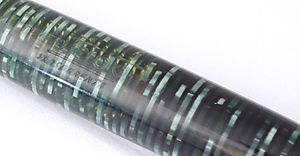
In the '40 was maintained only the arrow clip version, with three thin cap rings and jewel and metal decoration. On all models was engraved on the pen body the Tabo brand in lower case letters of larger dimensions, above the words TRASPARENTE in thinner uppercase letters. Beside the mark, at left and right respectively, were reported the data about the patent on the filling system, with the inscriptions brevetto ad n. 375925 in uppercase small letters.
The later versions of this model were built using a single ring on the cap, always with the arrow clip and the jewel and metal rings decorations at barrel bottom and cap top. This version has been found with copies of the clip also shaped in the early versions of the pen, whose origins are unknown.
Colors
The pens in this series were made in a variety of translucent ringed celluloid with beautiful colors, but there are also versions with black spirals and a variety of other colors with marbled or lozenges patterns. There is no known specific list of colors.
Nibs

The pens in this series were equipped with a 14-carat gold nib, bearing the engraving Tabo in capital letters above the Osmiridio inscription all over the carat weight value inside a diamond, expressed in thousandths. The steel nib versions always have theTabo' above the word Iridium, with no carat weight indication and only a number indicating the size of the nib.
Dimensions
| Version | Length | Width/Description |
|---|---|---|
| big | 1x.x cm | 1x mm cap, 11mm body |
| medium | 1x.x cm | 1x mm cap, 11mm body |
| small | 1x.x cm | 1x mm cap, 11mm body |
Chronology
| Year | Event |
|---|---|
| 1939 | the company introduces the Tabo Trasparente (guess date, stands for the end of '30s) |
| 1939 | Stiassi e Tantini become S.I.S.A. (Società Italiana Stilografiche e Affini) and starts usinig Tabo trademark |
| 1940 | S.I.S.A. (owner of Tabo trademark) become F.I.S.A. (Fabbrica Italiana Stilografiche e Affini) (approximate date[1]) |
External references
Notes
- ↑ supposed few time after S.I.S.A. foundation
Related material
Viene di seguito illustrato il materiale raccolto relativo a questo modello: le fotografie dello stesso, le pubblicità in cui compare o viene citato, le scansioni dei libretti di istruzione per il modello, ed tutte le altre scansioni contenenti informazioni ad esso attinenti.

